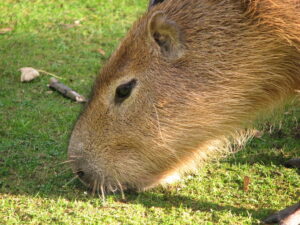The Role of Environmental Factors in Capybara Diseases
Capybaras are semi-aquatic animals, spending a significant amount of time in and around water. This lifestyle exposes them to a range of environmental factors that can influence their health. One of the most significant factors is water quality. Capybaras rely on clean water sources for drinking, bathing, and cooling off. However, polluted water can introduce harmful bacteria, parasites, and toxins into their bodies, leading to a variety of diseases.
For example, capybaras can contract leptospirosis, a bacterial infection caused by the Leptospira bacteria. This disease is often found in contaminated water and can cause severe kidney and liver damage, as well as reproductive issues. Another waterborne disease that capybaras may encounter is schistosomiasis, caused by parasitic flatworms. These parasites can cause inflammation and damage to the capybara’s internal organs, leading to weight loss, anemia, and even death.
In addition to water quality, the availability of suitable habitat plays a crucial role in capybara health. Capybaras require access to lush vegetation for food and shelter. However, habitat destruction and fragmentation can limit their access to these resources, leading to malnutrition and increased vulnerability to diseases. For instance, capybaras that lack access to adequate food sources may become weakened, making them more susceptible to infections such as pneumonia or skin diseases.
Climate change is another environmental factor that can impact capybara health. Rising temperatures and changing precipitation patterns can alter the distribution of diseases and their vectors, such as mosquitoes and ticks. This can lead to the emergence of new diseases or the spread of existing ones to previously unaffected areas. For example, capybaras may face an increased risk of contracting diseases like West Nile virus or Lyme disease as their habitats become more suitable for disease-carrying insects.
Furthermore, human activities can also contribute to the spread of capybara diseases. Deforestation, agriculture, and urbanization can disrupt capybara habitats, forcing them into closer contact with humans and domestic animals. This increased proximity can facilitate the transmission of diseases between species, such as the capybara-borne hantavirus, which can be transmitted to humans through contact with infected rodents or their excreta.
To mitigate the impact of environmental factors on capybara diseases, it is essential to implement conservation measures that protect their habitats and promote healthy ecosystems. This includes preserving wetlands and grasslands, reducing pollution, and monitoring water quality. Additionally, efforts to combat climate change, such as reducing greenhouse gas emissions and promoting sustainable land use practices, can help safeguard capybara populations from the emergence and spread of new diseases.
In conclusion, environmental factors play a significant role in capybara diseases. Water quality, habitat availability, climate change, and human activities can all influence the health of these gentle giants. By understanding and addressing these factors, we can help protect capybaras and ensure their continued survival in the wild. So, the next time you encounter a capybara, take a moment to appreciate their resilience and the delicate balance of their environment that allows them to thrive.
Recognizing and Treating Capybara Skin Conditions
One of the most common skin conditions in capybaras is ringworm, a fungal infection that can cause circular, scaly patches on their skin. These patches may appear red, inflamed, and itchy. If you notice any of these symptoms, it’s essential to consult a veterinarian for proper diagnosis and treatment. Ringworm is highly contagious, so it’s crucial to isolate the affected capybara from the rest of the group to prevent the spread of the infection. Treatment typically involves antifungal medication, and in severe cases, topical creams or oral medication may be necessary.
Another common skin condition is mites, tiny parasites that burrow into the capybara’s skin, causing intense itching and discomfort. Mites can be challenging to spot, but signs include excessive scratching, hair loss, and red, irritated skin. A veterinarian can diagnose mites through a skin scraping and prescribe appropriate medication to eliminate the infestation.
Fur mites, a specific type of mite, can cause a condition known as mange. Mange is characterized by thickened, scaly skin and hair loss. Treatment for mange involves medicated baths and topical treatments to kill the mites and soothe the skin.
Bacterial infections can also affect capybaras, leading to skin abscesses, which are painful, pus-filled lumps. These abscesses can occur anywhere on the body but are most common on the face, neck, and limbs. Treatment involves draining the abscess and administering antibiotics to clear the infection.
Fungal infections, such as yeast infections, can also affect capybaras, causing red, itchy patches on the skin. These infections are often a result of poor hygiene or a weakened immune system. Treatment involves antifungal medication and improving the capybara’s living conditions to prevent recurrence.
Skin allergies are another common issue, often caused by environmental factors or food allergies. Symptoms include red, itchy, and inflamed skin. Identifying the allergen is crucial for preventing future outbreaks. Treatment may involve changing the capybara’s diet or environment.
Sunburn is a less common but still possible skin condition in capybaras. These animals love basking in the sun, but too much exposure can lead to painful burns. Providing shade and limiting sun exposure during peak hours can help prevent sunburn.
Prevention is always better than cure, so maintaining a clean and hygienic environment for your capybara is essential. Regularly cleaning their living area, providing a balanced diet, and ensuring they have access to clean water can help prevent many skin conditions. Regularly inspecting your capybara’s skin for any signs of irritation or discomfort is also crucial.
If you notice any unusual skin conditions, consult a veterinarian immediately. Early detection and treatment are key
Capybara Vaccinations: A Guide to Keeping Your Pet Healthy
Capybara diseases are a topic that often goes unnoticed, but it’s essential to understand the potential health risks that these adorable creatures may face. As the world’s largest rodent, capybaras are fascinating animals that make great pets for those who are willing to put in the time and effort to care for them properly. However, like any other pet, capybaras are susceptible to various diseases, and it’s crucial to be aware of these potential health issues to ensure your capybara stays happy and healthy. In this article, we’ll explore some common capybara diseases and how vaccinations can help protect your furry friend.
One of the most common diseases that capybaras face is Capybara Herpesvirus (CvHV). This virus can cause respiratory and neurological issues, and in severe cases, it can be fatal. Symptoms include sneezing, coughing, and difficulty breathing. Unfortunately, there is no cure for CvHV, but vaccinations can help prevent the disease from occurring. It’s essential to consult with a veterinarian who specializes in exotic animals to determine the best vaccination plan for your capybara.
Another disease that capybaras may encounter is Leptospirosis, a bacterial infection that can be transmitted through contaminated water or soil. Leptospirosis can cause kidney and liver damage, and in severe cases, it can be fatal. Vaccinations can help protect your capybara from this disease, and it’s crucial to keep their living environment clean and free of standing water to reduce the risk of infection.
Capybaras are also susceptible to Parvovirus, a highly contagious virus that can cause severe gastrointestinal issues. Symptoms include vomiting, diarrhea, and dehydration. Vaccinations can help prevent this disease, and it’s essential to keep your capybara’s living area clean and sanitized to reduce the risk of infection.
Another disease that capybaras may face is Capybara Hepatitis, a viral infection that can cause liver damage. Symptoms include lethargy, loss of appetite, and jaundice. Vaccinations can help prevent this disease, and it’s essential to keep your capybara’s living area clean and sanitized to reduce the risk of infection.
Capybaras are also prone to Capybara Hepatitis E (CHE), a viral infection that can cause liver damage. Symptoms include lethargy, loss of appetite, and jaundice. Vaccinations can help prevent this disease, and it’s essential to keep your capybara’s living area clean and sanitized to reduce the risk of infection.
Capybaras are also susceptible to Capybara Hepatitis B (CHB), a viral infection that can cause liver damage. Symptoms include lethargy, loss of appetite, and jaundice. Vaccinations can help prevent this disease, and it’s essential to keep your capybara’s living area clean and sanitized to reduce the risk of infection.
Capybaras are also prone to Capybara Hepatitis C (CHC), a viral infection that can cause liver damage. Symptoms include lethargy, loss of appetite, and jaundice. Vaccinations can help prevent this
Parasitic Infections in Capybaras: Identification and Treatment
Parasitic infections in capybaras can be caused by a variety of organisms, including protozoa, helminths, and ectoparasites. These parasites can cause a range of health issues, from mild discomfort to severe illness, and can even be fatal if left untreated. Therefore, it is essential to be aware of the signs and symptoms of parasitic infections and to seek veterinary care promptly if you suspect your capybara may be affected.
One common parasitic infection in capybaras is caused by the protozoan Giardia. Giardia is a microscopic parasite that lives in the intestines of infected animals and can be transmitted through contaminated water or food. Infected capybaras may exhibit symptoms such as diarrhea, weight loss, and lethargy. To diagnose Giardia, a veterinarian will typically perform a fecal examination to identify the presence of the parasite.
Treatment for Giardia typically involves administering a medication called metronidazole, which is effective in killing the parasite. It is essential to follow the veterinarian’s instructions carefully and complete the full course of treatment to ensure the infection is fully eradicated. Additionally, it is crucial to maintain good hygiene practices, such as regularly cleaning the capybara’s living area and providing clean, fresh water, to prevent reinfection.
Another common parasitic infection in capybaras is caused by helminths, which are parasitic worms. These worms can infect the capybara’s digestive system, causing symptoms such as weight loss, diarrhea, and anemia. To diagnose helminth infections, a veterinarian will typically perform a fecal examination to identify the presence of worm eggs or larvae.
Treatment for helminth infections typically involves administering a deworming medication, such as fenbendazole or ivermectin, which is effective in killing the worms. It is essential to follow the veterinarian’s instructions carefully and complete the full course of treatment to ensure the infection is fully eradicated. Additionally, it is crucial to maintain good hygiene practices, such as regularly cleaning the capybara’s living area and providing clean, fresh water, to prevent reinfection.
Ectoparasites, such as ticks, fleas, and mites, can also infect capybaras, causing skin irritation, hair loss, and other symptoms. To diagnose ectoparasitic infections, a veterinarian will typically perform a physical examination and may use a magnifying glass or microscope to identify the presence of the parasites.
Treatment for ectoparasitic infections typically involves administering a topical or oral medication, such as fipronil or selamectin, which is effective in killing the parasites. It is essential to follow the veterinarian’s instructions carefully and complete the full course of treatment to ensure the infection is fully eradicated. Additionally, it is crucial to maintain good hygiene practices, such as regularly cleaning the capybara’s living area and providing clean, fresh water, to prevent reinfection.
The Impact of Nutrition on Capybara Well-being: Diet and Disease Prevention
Capybaras are herbivores, meaning they primarily consume plant-based foods. Their diet consists of grasses, aquatic plants, fruits, and tree bark. However, just like humans, their dietary choices play a significant role in their overall health. A well-balanced diet is crucial for capybaras to maintain optimal health and prevent diseases. In this article, we’ll delve into the importance of nutrition in capybara well-being and how it can help prevent common ailments.
A capybara’s diet is essential for its overall health and well-being. A balanced diet can help prevent diseases and promote a healthy lifestyle. A well-nourished capybara is less likely to suffer from common ailments such as gastrointestinal issues, dental problems, and parasitic infections. Let’s take a closer look at how nutrition impacts capybara health and how a balanced diet can help prevent these common ailments.
Gastrointestinal issues are common in capybaras, especially when they consume a diet that lacks essential nutrients. A diet rich in fiber, such as grasses and aquatic plants, helps maintain a healthy digestive system. Fiber aids in digestion and prevents constipation, which can lead to more severe health problems. A diet lacking in fiber can cause gastrointestinal issues, such as bloating, diarrhea, and even colic. A balanced diet can help prevent these issues and promote a healthy digestive system.
Dental problems are another common ailment in capybaras. Their teeth continuously grow throughout their lives, and a diet lacking in abrasive materials can lead to overgrown teeth, which can cause pain and difficulty eating. A diet rich in fibrous materials, such as tree bark, helps wear down their teeth and prevents dental issues. A balanced diet can help prevent dental problems and promote healthy teeth.
Parasitic infections are also common in capybaras. A diet rich in essential nutrients, such as vitamins and minerals, can help boost their immune system and prevent parasitic infections. A diet lacking in essential nutrients can weaken their immune system, making them more susceptible to parasitic infections. A balanced diet can help boost their immune system and prevent parasitic infections.
A balanced diet can also help prevent other common ailments, such as obesity and malnutrition. Obesity can lead to various health problems, such as heart disease and joint issues. Malnutrition can lead to weakened bones and muscles, making them more susceptible to injuries. A balanced diet can help prevent these issues and promote overall health.
In conclusion, a balanced diet is crucial for capybara well-being. A diet rich in fiber, essential nutrients, and abrasive materials can help prevent common ailments and promote a healthy lifestyle. A well-nourished capybara is less likely to suffer from gastrointestinal issues, dental problems, and parasitic infections. A balanced diet can also help prevent obesity and malnutrition, promoting overall health. As capybara owners, it’s essential to provide a balanced diet to ensure their well-
Understanding Capybara Health: Common Diseases and Prevention
One of the most common diseases that capybaras face is bloat. Bloat is a condition where the stomach becomes distended due to the accumulation of gas. This can be caused by a variety of factors, including dietary issues, parasites, or even stress. Symptoms of bloat include a swollen abdomen, discomfort, and lethargy. If left untreated, bloat can be life-threatening. To prevent bloat, it’s essential to provide capybaras with a balanced diet that includes plenty of fresh vegetables and hay. Additionally, regular deworming can help keep parasites at bay.
Another disease that capybaras may encounter is capybara herpesvirus. This virus can cause a range of symptoms, including respiratory issues, skin lesions, and even death. Unfortunately, there is no known cure for capybara herpesvirus, and prevention is the best course of action. To minimize the risk of infection, it’s crucial to maintain a clean and hygienic environment for your capybaras. Regularly cleaning their living space and providing them with fresh water can help reduce the chances of contracting this virus.
Capybaras are also prone to dental issues, such as overgrown teeth. These rodents have continuously growing teeth, which means they need to wear them down by chewing on hard objects. If they don’t have access to appropriate materials, their teeth can become overgrown, leading to pain and difficulty eating. To prevent dental issues, ensure that your capybaras have access to a variety of chew toys and roughage, such as branches and rocks. Regularly monitoring their teeth can also help catch any potential problems early on.
In addition to these diseases, capybaras can also suffer from skin infections, such as ringworm. Ringworm is a fungal infection that can cause circular, scaly patches on the skin. It’s highly contagious and can spread to other animals and even humans. To prevent ringworm, it’s essential to maintain a clean and dry environment for your capybaras. Regularly cleaning their living space and providing them with a dry bedding can help reduce the risk of infection.
Lastly, capybaras can be affected by parasites, such as ticks and fleas. These pests can cause discomfort and transmit diseases to your capybaras. To prevent infestations, it’s crucial to regularly check your capybaras for any signs of parasites and treat them promptly. Additionally, keeping their living space clean and free of debris can help deter pests from making a home in their environment.
In conclusion, while capybaras are generally hardy creatures, they are still susceptible to various diseases. By understanding the common ailments that capybaras face and implementing preventative measures, you can help ensure that your capybaras stay healthy and happy. Remember to provide them with a balanced diet, maintain a clean living environment, and regularly monitor their health. With proper care and attention, your capybaras will thrive and continue to bring joy to your life.
Q&A
1. Q: What is the most common disease affecting capybaras?
A: The most common disease affecting capybaras is bovine tuberculosis, caused by Mycobacterium bovis.
2. Q: Can capybaras contract rabies?
A: Yes, capybaras can contract rabies, which is a viral disease that affects the central nervous system.
3. Q: What is the impact of leptospirosis on capybaras?
A: Leptospirosis is a bacterial infection that can cause kidney damage, liver failure, and even death in capybaras.
4. Q: Are capybaras susceptible to parasites?
A: Yes, capybaras can be affected by various parasites, including ticks, fleas, and mites.
5. Q: Can capybaras suffer from dental problems?
A: Yes, capybaras can suffer from dental issues, such as overgrown teeth, which can lead to difficulty eating and malnutrition.
6. Q: What is the impact of capybaras contracting the West Nile virus?
A: The West Nile virus can cause neurological symptoms in capybaras, including paralysis and death.






